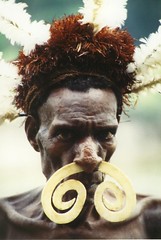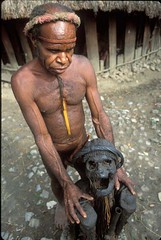Tree Dwellers – The Korowai TribeDeep amongst the remote lowland forests, in the south east of Papua, the Korowai tribe are the first people to be officially recognised as tree dwellers according to the 2010 census. They are a nomadic people, building their houses high in the forest canopy, and moving according to the seasons to maintain food and shelter.
The houses, lashed with sago fronds, sway in the wind 50 meters above the forest floor. Each wooden hut can be a home for up to 8 family members, providing protection against the elements, mosquito born diseases and rival warriors.
|
 |  |
Pygmies – Yali TribeHigh up on the valley ridges of the Jayawijaya Mountains live the Yali tribe of West Papua. Located 35 miles southeast of Wamena, a trek to the Yali encampment is a beautiful yet arduous hike. The path is oftentimes hazardous, consisting of little more than a wet and rugged mountain trail. With men standing at just 150cm tall, the tribe are officially recognised as pygmies.
Some 30,000 Yali live off the land, hunting animals in the jungle and growing vegetables on the surrounding land. The Yali tribe reside in wooden huts with roofs constructed of tree bark or palm leaves. Each individual compound is surrounded by a family’s own vegetable garden.
|
 |  |
Cannibals – Asmat TribeAs far as cannibalistic cultures go, the Asmat tribe of Papua, Indonesia earned their place in the journals. Living amongst the tidal swamps of West Papua’s south coast, the Asmat tribe were propelled to fame after the unexplained disappearance of Michael Rockefeller, the son of a New York governor. At the time of his disappearance, Rockefeller was travelling the region as a collector of native artwork; his body has never been recovered.
First contact with the Asmat tribe was established by Dutch explorers as early as 1623, yet due to their ferocious nature and formidable reputation, prolonged contact was not established until the 1920’s. It was not until the 1950’s, conscious of outside influences that the Asmat tribe started to abandon their cannibalistic traditions.
|
 |  |
Smoked Mummies – Dani & Lani Tribes Surrounded by the peaks of vast mountain ranges, the Dani tribe inhabit the most fertile stretch of land in the west of Papua. Unfortunately, as a direct consequence the tribal lands were also the most sought after in the region and the Dani had to fight hard to maintain control. Although the tribe did not indulge in cannibalistic tendencies, they built up a steadfast reputation as incredibly fierce warriors.
The most famous warriors and tribal chiefs are preserved as smoked mummies that the tribe are only too happy to display for visitors. The villages of Akima and Jiwika are popular for travellers who wish to admire their handiworks.
|
 |  |
Tattoos & Tooth Sharpening – Mentawai TribeThe Mentawai islands are gaining a well deserved reputation as one of the best surfing spots, off the coast of Padang in West Sumatra. But, this small cluster of islands hides another secret in addition to the awesome swells. Amongst the coastal, rainforest environment of the islands, some 64,000 members of the Mentawai tribe reside, some of whom still follow the traditional semi nomadic lifestyle. Although most have been lured into government towns by promises of a better life, others have chosen to spurn the new ways and remain in the mountainous jungle regions.
The Mentawai tribe have a tradition of tattoos and tooth sharpening, procedures that the locals indulge in, to make their members a touch more ‘elegant’.
|
 |  |
Modern Day Headhunters – The Iban or Sea DayaksThe Iban were a notorious warring faction, renowned in the region as pirates and fishermen. Because of their reputation, British Colonists began to refer to the tribe as the Sea Dayaks. They made a living as farmers and hunter-gatherers and were feared for their cultural heritage of headhunting. Recognised as some of the original inhabitants of Borneo, the Iban certainly pursued a bloody path. Today many anthropologists suggest, that their culture of headhunting and constant warfare was essential to maintain life on an otherwise overcrowded island.
These days, the Iban have become increasingly urbanised but they still maintain their original heritage, passing knowledge and skills on to younger generations. Many of the Iban still live in traditional longhouses, but today these are equipped with modern facilities including running water, electricity, telephones and even the internet.
|
 |  |
Old People of Bali – The Bali AgaAlthough not a tribe, the Bali Aga are known locally as ‘the old people of Bali’. Living in walled villages with gates that, until recently, remained closed to the outside world. This has resulted in a culture that has changed little over time, preserving a lifestyle significantly different to that throughout the rest of the island. Two main villages exist today that can be visited by travellers in the region, these are Trunyan (Near Kintomani) and Tenganan (Near Candidasa, East Bali).
|
 |  |
















0 komentar:
Posting Komentar